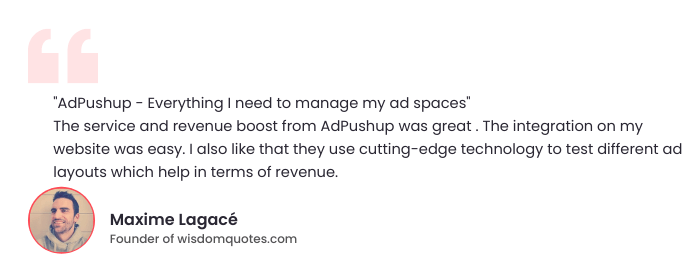This blog covers information on how publishers can boost their Video Ad Revenue by following simple metrics and guidelines.
Although it is true that a huge percentage of visitors have grown immune to video ads, it is safe to say that video advertisements have the capacity to entice and capture audiences at large. Most advertisers are aware of this scenario, and they are pushing stronger investments in video advertising to ensure that the message that they are sending last considerably long.
According to a report by eMarketer, the US digital advertising expenses are going to reach as much as 53.39% billion by the end of 2023. Moreover, From 2022-2023, the global market of programmatic display is expected to show a CAGR of 35%.
Although nowadays a number of ad-free options are there, traditional TV habits have made users more accustomed to ad breaks.
Moreover, when compared to only display ads, audio and video inputs combined often leads to a stronger impression on the viewer. What this essentially means is that publishers are getting a huge opportunity to grow their revenues, enriching the experience of the users at the same time – all this culminating in satisfying advertisers as well. To make the discussion somewhat more concrete, let’s go over the following points in this article:
Also Read: Video Advertising: A Complete Guide for Publishers
The Metrics that Matter to Increase your Video Ad Revenue
When it comes to video, advertisers are much more interested in the metrics concerning viewability and engagement, of course, because of the investment they make to create the video ad, and thereafter the opportunity for interaction is quite a lot more than traditional display ads.
The Metrics that are Usually Tracked are:
- Video Viewership
- Quartile Reporting
- Completed Ad Views
- Full-Screen Expansion
Ad Viewability has been defined by the Media Rating Council or MRC as viewing 50% pixels for at least 2 seconds. Being a publisher, you have to ensure that your ad server is able to accommodate any request on the part of the advertiser to be part of the contract.
Read More: 7 Video Ads Best Practices to Follow in 2023
Seeking Video CPM Rate
You have to consider the fact that the video ads inventory is usually quite scanty when compared to display ads. In spite of that, the expenditure on video ads reaches almost half of that of display ads. Again, video CPMs are somewhere from 3 times to 10 times higher than display. So, if the publishers can optimize for high video CPMs, the returns will also increase. This is how that can be done:
- Try to drive the traffic from the social channels towards the properties owned and operated by you
- You can make the ad experience a little less disruptive for the users by adding the feature – “Click to Play”.
- The Player should be made the focus of your page.
- Make sure your content is quite engaging – This is what will compel your viewers to sit through the ad
- You can provide the buyers with a Placement ID and a Deal ID – This helps promote transparency, and advertisers will be more interested anytime to spend more CPMs on inventory that is identified.
Improvement of Pre-Bid Targeting Ratings
The aspect of creating content that is engaging and compelling also has some secondary positive effects – it improves the ranking of the publishers in pre-bid targeting. If the inventory is being purchased through a DSP, the advertisers can consider their targeting and practice strategies relying on pre-bid viewability ratings.
The ratings predict the quality of inventory based on the historic data of viewability for each and every placement and publisher. After this, the marketer is allowed to define the rules on whether predicted ad viewability can be used as the basis of bidding.

Top Actionable Ways to Boost Your Video Ad Revenue
It is true that revenue generation from video ads might be unpredictable. But let’s not consider that as an ultimate statement. There are a number of ways to get the best out of your ad creatives, and here are some of them:
Stop Relying on a Single Network
One major mistake that publishers make is relying on a single network of advertising. This is because no ad network has the capacity to cover all of your ad inventory, realistically speaking. After signing a contract with one ad network, they think that they are all good and wait for success to crash their gates. The disappointment comes later with subpar fill rates.
The very basic knowledge of the online advertising industry will tell you that no single ad network has the capability of achieving 100% fill rates.
So the idea is to work with a number of providers at the same time. This way, if the ad call from one of them does not bear fruit, you will always have a backup.
Also Read: The Top 15 Video Ad Networks for Publishers (2023 Update)
Use Ad Pods for Sequencing Multiple Pre-Rolls
Ad pods might be a quite recent addition to the online advertising industry, but they have become quite popular very fast. They are also one of the most sought features in the industry at the moment.
Ad Pods basically refer to a feature that allows one to queue up multiple ad tags, including pre-, mid-, or post-roll ones. Simply put, this allows you to play multiple ads one after another. As a result, this has recently become quite an efficient way to increase your ad revenue from videos.
Header Bidding Technology Can Save the Day
Pre-Bidding and Header-Bidding are the keywords of the online ad industry these days, and the reasons are nothing. It is essentially an advanced technique of programmatic advertising where the publishers get to offer their ad inventory simultaneously to a number of ad exchanges.
Here, advertisers bid for the inventory available, and the publishers get to sell it to the bidder who bids the highest.
It is evident, therefore, how this feature has become quite popular and sought-after. Publishers are hereby able to earn more revenue by getting their inventories to bid on by the advertisers, which helps them to always get a better deal.
Use all Your Fallback Options
The worst thing that can happen to a publisher is their ad calls turning up empty. However, this happens more often than not, and there is no way to avoid this. But there are indeed ways to minimize the chances of this happening. Therefore, if you want to maximize your ad revenue, you have to implement all your fallback options and minimize your losses.
In a Nutshell
So, in essence, although subpar fill rates are a menace, that doesn’t mean that you can’t do anything to increase your ad revenues. As discussed, there are a number of ways to increase the revenues from your advertising efforts. Take a good look at the ones that are viable for you, that you implement with ease, and find out how uncomplicated revenue increasing actually is.
One way to increase the revenue from video ads is to optimize your website for ad placements. This can include using ad-friendly layouts and designs, as well as ensuring that your website has a high level of traffic. You can also consider using ad networks or monetization platforms, which can help you connect with advertisers and increase the number of video ads shown on your site.
AdPushup helps maximize your yield on web inventory with the new video ad units. Sign up here to talk to our experts on video ad revenue optimization.
FAQ
According to industry standards, you can earn between $2 and $12 per 1,000 views from video ads. But views on your video ads are not like same as ad views. Only half of your views across the video ads will be monetized.
Interactive Video Ads are the most effective when it comes to revenue part. They also help to increase engagement.
To improve your website’s video ad performance, you can try the following strategies:
1) Use video ad placements that are visible and easy to interact with
2) Use video ad formats that are relevant and engaging to your audience
3) Test different ad formats and placements to see which ones perform the best
4) Monitor your website’s ad performance and make adjustments as needed
5) Consider using ad targeting to show ads to a specific audience or demographic

Shubham is a digital marketer with rich experience working in the advertisement technology industry. He has vast experience in the programmatic industry, driving business strategy and scaling functions including but not limited to growth and marketing, Operations, process optimization, and Sales.








